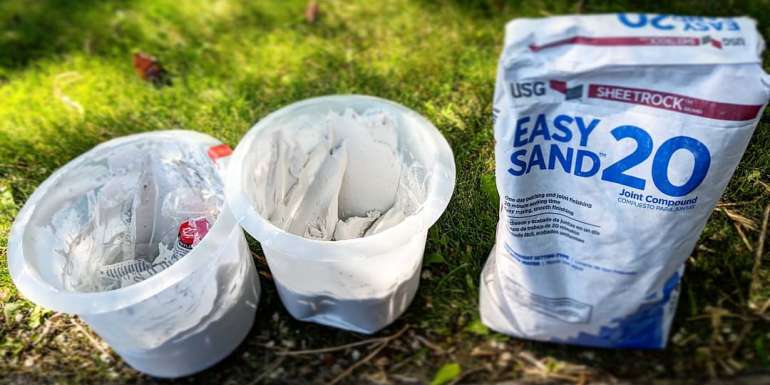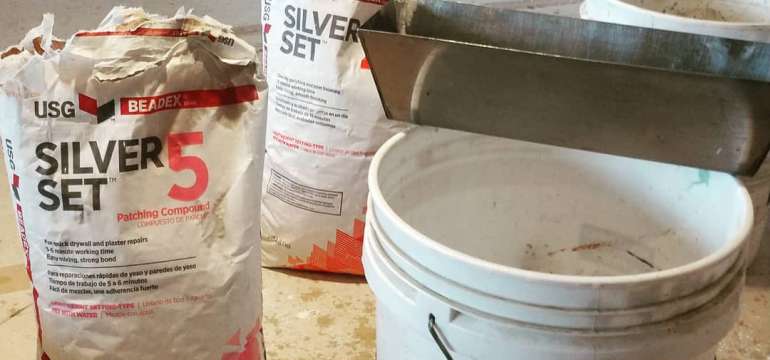If you’re new to the home improvement scene, you may be shocked by how many different types of drywall and drywall supplies there are. And the first time you hear the term “hot mud,” you might picture brown, goopy soil at high temperatures. If you’re not sure how to use hot mud, or what it is, keep reading for the complete guide to the hot mud drywall process.
What is mudding?
Mudding involves layering thin coats of a special compound over the drywall joints, scraping it smooth, and ensuring that all cracks and crevices are covered so you have a nice, flat surface to paint later. You may have to apply several coats of drywall mud, depending on the condition of the wall.
The compound you’ll use, far from being brown like regular mud, is typically white, textured like paste. Once you apply it, it needs time to dry and cure, and then it will need to be sanded smooth before you can proceed to the next step.
What is hot mud for drywall?
“Hot mud” is simply a term used to refer to the drywall compound that you mix up yourself. The word “hot” indicates that once you mix up a batch, you’d better get started and use it quickly because it will begin to set within the amount of time listed on the bag.

Hot mud drywall mix comes in powder form, usually packaged in paper bags with a tough plastic lining to keep moisture out.
Why choose hot mud drywall products?
You can buy pre-mixed drywall compound, but some contractors and homeowners prefer to mix the compound themselves so they can obtain the consistency they want. Plus, hot mud tends to be cheaper, since the burden of the labor rests on the purchaser.
Hot mud drywall products tend to act like cement once they’re mixed in that they have a limited lifespan before they harden beyond usability. However, the hot mud drywall compound gives you a tough bond and sturdy result.
In addition, these compounds often dry faster than the pre-mixed versions. If you’d rather not wait around for hours to start the next step in your project, a hot mud drywall compound might be the right choice for you.
Hot mud deadlines

When you purchase the bags of powder for mixing up your hot mud, be sure to choose a variety that suits your timeline. For example, some types of hot mud set very quickly. Silver Set 20 by Beadex can be worked for only 20 minutes before it begins to set.
You’ll find bags labeled with other time limits, like 40 minutes or 90 minutes. Consider the size of your project and select a type of hot mud with a workable time span.
When to start mudding?
When you’re preparing a wall for finishing, you first place the sheets or panels of drywall and screw them to the studs. Make sure all your screws are drilled in tight, and then pack that drywall compound firmly into the crevices and scrape it smooth. Next, tape those sections with paper drywall tape, self-stick fiberglass tape, or a similar option.
Once the room is taped, you can use more drywall mud along the joints of the drywall sections. The seams at the edges of the rooms are particularly important and difficult to do, so take your time on the corners and along the lines where the walls meet the floor or ceiling. You can purchase inside corner tools to make these areas easier to treat.
How to use hot mud?
Be sure you have all your tools on hand: paddles, knives, buckets, trays, hot mud drywall mix, a face mask or filter, and a power mixer to stir the compound. As with any chemical substance, follow the instructions on the package precisely and adhere to any rules of safe usage. You should begin by filling your mixture bucket with water; if you put the powder in first, the texture of your hot mud won’t be right.
If your compound looks too soupy, add more powder. If it’s too thick, add a bit of water. It may take a few tries to get a perfect consistency, which is a thick yet workable paste, almost like cake frosting. Always mix a little more compound than you expect to need, so you don’t have to stop in the middle of the job to mix up more.
Keep in mind that hot mud doesn’t always provide the smoothest finish. If the consistency isn’t just right, you may end up with a bumpy or grainy surface. You can sand the imperfections or use a final layer of pre-mixed, all-purpose mud to finish things off.
If you’re nervous about using hot mud drywall compound the first time, choose a single wall or a small section of the room, rather than attempting an entire room in one sitting. Once you’ve played around with the compound, you’ll feel more comfortable hot mudding the other areas of your space that need attention.
- How to Cut Lexan - September 25, 2020
- Mineral Spirits vs. Mineral Oil - September 25, 2020
- Shellac vs. Polyurethane - September 24, 2020
